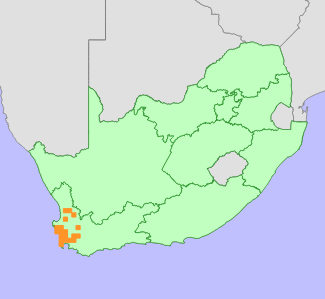|
Scientific Name | Lachnaea capitata (L.) Crantz |
Higher Classification | Dicotyledons |
Family | THYMELAEACEAE |
Common Names | Lanky Stringbark (e) |
National Status |
Status and Criteria | Vulnerable A2ac |
Assessment Date | 2006/08/22 |
Assessor(s) | J.B.P. Beyers, N.A. Helme & D. Raimondo |
Justification | Eighty of the 117 herbarium records for this species were collected before 1980 and it is now extinct at most of these locations. It has suffered a minimum of a 30% decline over the past three generations (30 years). |
Distribution |
Endemism | South African endemic |
Provincial distribution | Western Cape |
Range | Clanwilliam to Cape Peninsula to Franschhoek and the Breede River Valley. |
Habitat and Ecology |
Major system | Terrestrial |
Major habitats | Cape Flats Dune Strandveld, Saldanha Flats Strandveld, Winterhoek Sandstone Fynbos, Cederberg Sandstone Fynbos, Hawequas Sandstone Fynbos, Breede Shale Fynbos, Boland Granite Fynbos, Breede Sand Fynbos, Hangklip Sand Fynbos, Cape Flats Sand Fynbos, Atlantis Sand Fynbos, Hopefield Sand Fynbos, Leipoldtville Sand Fynbos, Swartland Alluvium Fynbos, Breede Alluvium Fynbos |
Description | Acid sand flats, often seasonally damp. |
Threats |
| It may have disappeared from the Cape Peninsula as a result of urban development as no recent collections have been made. Only a very few recent collections are known from the sandy flats up the west coast and in the Tygerberg area (Beyers revision). N.A. Helme (2006) listed urbanisation (Cape Flats), agriculture (esp. vineyards, potatoes, rooibos); invasive alien species (acacia - severe) as threats to this species. |
Population |
Population trend | Decreasing |
Assessment History |
Taxon assessed |
Status and Criteria |
Citation/Red List version | | Lachnaea capitata (L.) Crantz | VU A2ac | Raimondo et al. (2009) | | Lachnaea capitata (L.) Crantz | VU A1c | Victor (2002) | |
Bibliography |
Goldblatt, P. and Manning, J.C. 2000. Cape Plants: A conspectus of the Cape Flora of South Africa. Strelitzia 9. National Botanical Institute, Cape Town.
Raimondo, D., von Staden, L., Foden, W., Victor, J.E., Helme, N.A., Turner, R.C., Kamundi, D.A. and Manyama, P.A. 2009. Red List of South African Plants. Strelitzia 25. South African National Biodiversity Institute, Pretoria.
Victor, J.E. 2002. South Africa. In: J.S. Golding (ed), Southern African plant Red Data Lists. Southern African Botanical Diversity Network Report 14 (pp. 93-120), SABONET, Pretoria.
|
Citation |
| Beyers, J.B.P., Helme, N.A. & Raimondo, D. 2006. Lachnaea capitata (L.) Crantz. National Assessment: Red List of South African Plants version 2024.1. Accessed on 2025/12/04 |
 Comment on this assessment
Comment on this assessment

